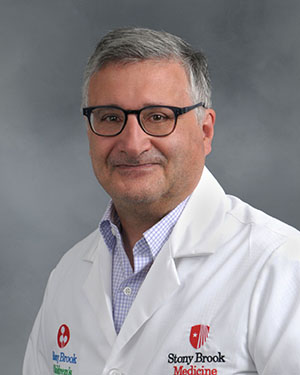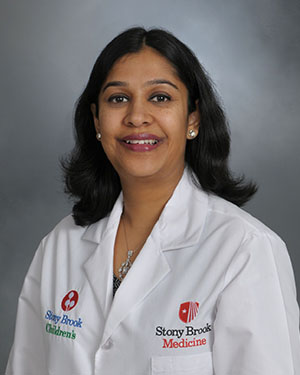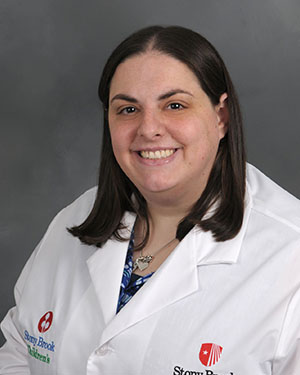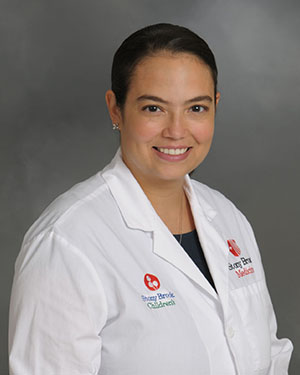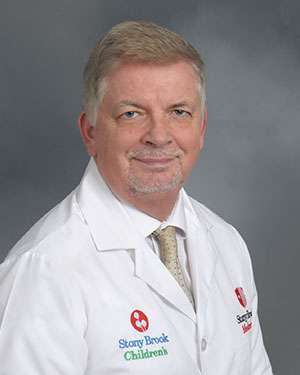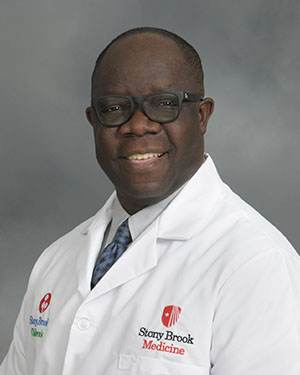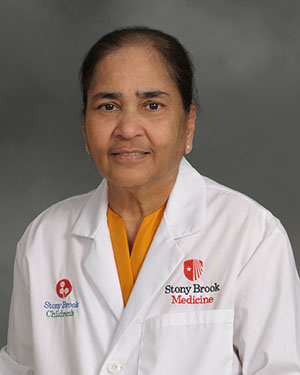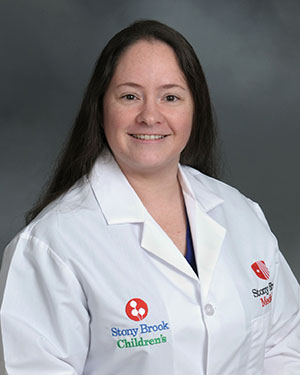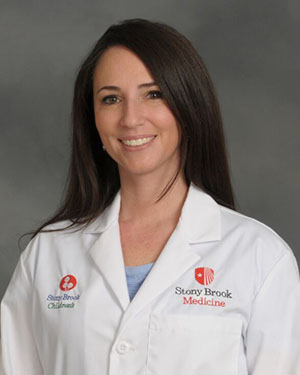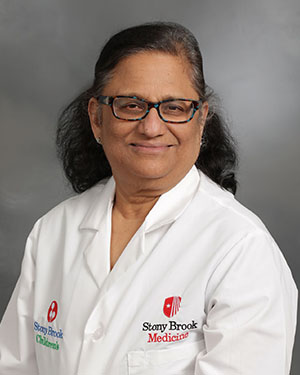Navigation Neonatology
Neonatology
In partnership with the Division of Maternal-Fetal Medicine, our Perinatal Center is a New York State Department of Health-designated Regional Perinatal Center.
Our center is responsible for establishing the highest level of neonatal and obstetrical care and education in Suffolk County, Long Island, and beyond. Every year, Stony Brook Medicine takes approximately 1,000 admissions to the Neonatal Intensive Care Unit (NICU), 100 neonatal transports, 200 maternal transports, 90 newborns weighing less than 1,500 grams, and 4,000 inborn deliveries.
Services
Stony Brook Children’s Neonatal Intensive Care Unit (NICU) includes:
- A 46-bed NICU with all-private rooms. This means that babies have their own rooms, which, in turn, allows the nursing staff to better control the environment — critical factors such as lighting, noise, and temperature. This setting is optimal for the developmental care of babies. It also is optimal for family-centered care because privacy encourages and empowers parents to bond with their babies and be involved in the care plan.
- The ability to keep NICU twins in the same room.
- A new Labor and Delivery Suite, including 10 labor suites with private baths and recovery rooms.
- Expanded maternity urgent care capacity that can deal with any kind of obstetric emergency 24/7. This includes three state-of-the-art operating rooms adjacent to the labor suites and a dedicated anesthesiologist, who is also available 24/7.
Because many of our NICU graduates need further medical care and close observation after discharge, we have an outpatient follow-up program every Monday afternoon.
All high-risk patients are seen regularly to ensure continued developmental progress and appropriate interventions to keep them on track.
Our NICU High Risk Clinic is located a few minutes away from the hospital at 4 Smith Haven Mall, Suite 101 in Lake Grove. Appointments are scheduled at the time of discharge and through (631) 444-KIDS (5437).
When a newborn premature or full-term baby is diagnosed with Hypoxic Ischemic Encephalopathy (HIE), a brain injury caused by lack of oxygen, it can result in life-long problems and even death. But, when a special treatment called Therapeutic Hypothermia, using Whole Body Cooling, is started very soon after birth, damage can be reduced and there can be better outcomes for the infant. The treatment, which involves reducing the infant’s temperature for 72 hours, has been shown to prevent further damage and promote healing.
Stony Brook is the only regional center in Suffolk County that offers this proven treatment.
Stony Brook is the first academic hospital in New York State to publish work describing the feasibility of immunizing parents of NICU graduates for pertussis (whooping cough), which is a growing problem in the United States due to waning of antibody protection from childhood in parents.
Pertussis, like influenza or respiratory syncytial viral infection, can lead to extreme illness, especially in a NICU graduate who had a previous lung disorder. In the Stony Brook study, immunization of the parents occurred before or at discharge of their baby. As a result of Stony Brook’s lead, New York State has passed a law that promotes pertussis immunization to parents of NICU graduates.
When a newborn premature or full-term baby is diagnosed with Hypoxic Ischemic Encephalopathy (HIE), a brain injury caused by lack of oxygen, it can result in life-long problems and even death. But, when a special treatment called Therapeutic Hypothermia, using Whole Body Cooling, is started very soon after birth, damage can be reduced and there can be better outcomes for the infant.
The treatment, which involves reducing the infant’s temperature for 72 hours, has been shown to prevent further damage and promote healing.
Stony Brook is the only regional center in Suffolk County that offers this proven treatment.
Our Team
The neonatal team includes board-certified or board-eligible attending neonatologists, neonatal fellows, neonatal nurse practitioners, more than 110 dedicated neonatal nurses, a discharge coordinator, a neonatal social service worker, a dedicated neonatal nutritionist and lactation consultant, a bereavement counselor, chaplaincy services, an ethicist, nurse educators, dedicated respiratory therapists, and other ancillary support staff.
All are committed to delivering compassionate, family-centered, medically advanced, and developmentally sensitive care to the smallest and sickest babies. For complex neonatal disorders, we have full-time attending consultants in every subspecialty of pediatrics available, such as cardiology, neurology, infectious disease, surgery, and whatever else the baby may need.
To ensure optimal patient safety and best outcomes, we use a strategy called Team STEPPS. This evidence-based success story from the US Department of Health teaches staff leadership skills, meticulous monitoring of patients, and mutual support and communication techniques.
The Division of Neonatal-Perinatal Medicine also provides the highest level of quality and safety for the best outcomes by having attending neonatologists in-house 24/7.
Neonatal Transport Team
For babies born at level I, II and III hospitals in our region who need Regional Perinatal Center-level intensive care, a dedicated neonatal team with specialized equipment is available 24/7. Our state-of-the-art transport incubators include the ability to deliver nitric oxide for newborns with severe hypoxic respiratory failure.
Neonatal Nurse Practitioner Team
Our neonatal nurse practitioner (NNP) team works collaboratively with the attending neonatologists. The nurse practitioner team makes workflow (rounds) highly efficient so attending physicians can spend more time with families and students.
Having such a stable NNP team provides continuity of safety and best practices for best outcomes over a period of months and years. Some of our NNPs have or are working toward doctorate degrees. Those with experience and advanced academic degree act as faculty members to teach neonatal fellows, pediatric residents, medical students and NNP students. They also play a critical role in simulation education and transport of critically ill babies from regional hospitals. Besides PubMed, their publications can be found on CINAHAL Plus.
- Danielle Blackmore, NNP
- Siobhan Cassidy, CNNP, MS
- Tram Dang, MS, NNP-BC
- Nancy Enterlin, MS, NNP-BC
- Kristin Ferrara, NNP-BC (Stony Brook Southampton Hospital)
- Annemarie Folken, MS, NNP-BC
- Jennifer Haas, MS, NNP-BC
- Susan Katz, DNP
- Charlene Lyons, MS, NNP-BC
- Pamela Minett, MS, NNP-BC
- Elizabeth Perri, NNP
- Kerry A. Walsh, MS, PNP, NNP-BC
Nursing Leadership
- Alyson Ornstein (Regional Perinatal Center Coordinator)
Fellows
- Vivian Chang, MD (Co-Chief)
- Daniel Helfgott, MD (Co-Chief)
- Anupriya Bhatia, MD
- Abeer Islam, MD
- Omar Ibarra Aleman, DO
Biographies
Shanthy Sridhar, MD
Professor of Pediatrics, Medical Director NICU, Associate Program Director. She graduated as a fellow from SUNY Downstate Medical Center and joined Stony Brook Medicine in 1999. Dr. Sridhar has been instrumental in implementing daily IHI/Multidisciplinary Quality Improvement rounds on low birth weight infants since 2006. She has been involved with many collaborative clinical trials and quality improvement studies in infection control, nutrition and oxygen therapy. Dr. Sridhar recently completed work as the onsite principal investigator for the NIPPV Study (Nasal Intermittent Positive Pressure Ventilation in Preterm Infants-Neonatal trials Group). She currently is the onsite principal investigator for the COT study (Efficacy and Safety of Targeting Lower Arterial Oxygen Saturation to Reduce Oxygen Toxicity and Oxidative Stress in Very Preterm Infants) and the on-site Principal Investigator for Synergistic Pharmacologic Prevention of ROP Grant Award with SUNY Pharmacology Consortium.
Echezona Maduekwe, MD
Assistant Professor of Pediatrics joined Stony Brook Medicine in 2013. He completed his fellowship training at Golisano Children's Hospital University of Rochester where he was recognized as the Bradford Fellow by the Department of Pediatrics. He is board certified in Pediatrics. His research interest during his fellowship was in hyperoxic injury to the neonatal lung. He tested the hypothesis that cumulative oxygen, represented as concentration and duration of oxygen exposure (i.e. "oxygen area under the curve"), can be used to define levels of oxygen toxicity sufficient to impair host response to viral infection in mice - funded by NIH T32 Department of Pediatrics grant, "Bench to Bedside to Curbside." His overall research interests include studies relating to oxygen delivery and its impact in neonates. Dr. Maduekwe's future interest is in improving the care of the neonates in our region through a perinatal outreach program.
Hormuz Nicolwala, MD
Dr. Nicolwala was born in the United Kingdom and moved to Texas in 1997. The son of practicing physicians, Hormuz attended Texas A&M University, obtaining a Bachelor of Science degree with honors in Biology. Following graduation, he attended Texas A&M Health Science Center for medical school, graduating in 2015. Looking for a new start and a new place to set roots, he attended West Virginia University Pediatric Residency Program for training. Even before starting residency, Hormuz knew he wanted to be a future intensivist. He always had a passion to serve on the front lines, provide care to the sickest children and guide parents through the most difficult of times. In his spare time, he enjoys listening to music having been a former radio DJ in college, attending sporting events and bowling.
Aruna Parekh, MD
Associate Professor of Pediatrics, Director of NICU High Risk Follow-up Clinic, came to Stony Brook Medicine in 2010 as a Clinical Associate Professor. She brought with her more than 35 years of clinical and academic neonatology experience. Prior to her arrival, she was a faculty member at SUNY Downstate Medical Center in the departments of Pediatrics and Psychiatry and Chief of Neonatology at its affiliate Hospital, Long Island College Hospital in Brooklyn. Dr. Parekh has been actively involved in teaching medical students, residents, neonatal fellows, nurse practitioners, physician assistants, occupational therapists, speech therapists and physical therapists. Her area of interest has been in long-term follow-up and impact of early intervention on NICU graduates. As a medical director, she established an early intervention program in Brooklyn and ran an infant and child learning center (SUNY Research Foundation).
At Stony Brook, she is in charge of the High-Risk Follow-up Clinic. She also is involved in collaborative multicenter research projects involving NICU graduates enrolled in several trials looking at multiple doses of surfactant, nitric oxide and different levels of oxygen concentrations on long-term pulmonary and neurologic outcomes. In addition, she is interested in quality assurance projects looking at best methods of training for neonatal intubation using simulation methodology.
Margaret Pearce, MD
Dr. Pearce comes to us from Richmond University Medical Center, an affiliate of The Mount Sinai School of Medicine, where she completed her Pediatric Residency and was Chief resident. Prior to her residency she earned her Bachelor of Science in Health Education and Behavior at the University of Florida and her medical degree at Ross University School of Medicine. During residency, Meg was involved in multiple research/quality improvement projects including Decreasing the Rate of Invalid Newborn Screening Samples in the Newborn Nursery and Childhood Asthma Education, both of which were presented at the AAP National Conference and Exhibition. She also helped to establish the Asthma Coalition of Staten Island. Most of Margret’s free time is spent chasing around her son, but she also enjoys crafting, gardening, and music. She plays the piano and saxophone, and actually had the opportunity to march in the Rose Bowl Parade. Her love for crafting was turned into an online business offering eco-friendly products during undergraduate school.
Jennifer Pynn, MD
Assistant Professor of Pediatrics, Fellowship Program Director, joined Stony Brook Medicine in 2011. She completed her fellowship training at Columbia’s Morgan Stanley Children’s Hospital and is board certified in Neonatal-Perinatal Medicine. During her fellowship, she participated in research to determine new methods of detecting infection in the newborn, specifically the role of urinary NGAL as a potential marker for late onset sepsis among NICU patients. She is taking advanced courses in education and Neonatal Perinatal Medicine Fellowship Director for the Division of Neonatology -- setting the curriculum for the fellows and residents, as well as setting the standards for best teaching methods for adult learners.
Esther Speer, MD
Assistant Professor of Pediatrics, joined Stony Brook Medicine in 2009. She completed her fellowship training at the University of Chicago, where she participated in research on the genetic causes of preterm delivery and the impact of intrauterine infections on the outcome of extremely low gestational age newborns. Her current research work aims to identify potential therapeutic agents that can down regulate the pathological inflammatory response syndrome found in term and preterm neonates exposed to intrauterine infections. Dr. Speer continues as an active faculty member in the Neonatal Research Center, with a focus on molecular regulation underlying the different inflammatory responses of monocytes from newborns and adults to bacterial infection. In addition, Dr. Speer is interested in the clinical outcome of extremely low birth weight newborns.
Lynn Marie Antonawich, MS, RN
Assistant Director of Nursing for the NICU, joined Stony Brook Medicine in 2012. She received her Bachelor of Nursing degree from the State University of New York at Plattsburgh in 1989 and began her nursing career in Labor and Delivery at Good Samaritan Hospital in West Islip. After five years, she moved to the Neonatal Intensive Care Unit where she helped to develop the unit to a Level 3 NICU. Lynn earned her Master’s in Nursing Administration from Adelphi University, graduating Magna Cum Laude. Prior to joining Stony Brook, she served as the Nurse Manager for Good Samaritan’s NICU for five years, helping the hospital to obtain Magnet status. She currently serves as a consultant and editor for both Wolters and Kluwer Publishing companies, is a member of both the New York Organization of Nurse Executives and the American Organization of Nurse Executives and is an Active member of the National Association of Neonatal Nurses.
Kerry A. Walsh, MS, PNP, NNP-BC
Ms. Walsh is a senior nurse practitioner in the NICU. She earned her Bachelor of Nursing degree from Molloy College in 1986, her MS, PNP in 1992 and her NNP in 1994 from Stony Brook University. She began her career as a Neonatal Nurse in 1986, then pursued her MS as a Pediatric Nurse Practitioner and joined the medical staff running the transitional nursery. Enthusiastic to continue her education and her desire to care for the sickest, extremely premature infants and their families, she earned a post Master’s, NNP degree. Kerry has been an integral part of the NNP team for the past 20 years and continues to be a leader on the unit. She is involved in teaching nurses, students, residents and fellows. She is an NRP instructor and an expert in newborn resuscitation. She is a member of the transport team and provides outreach services and support to community hospitals in the area. Her special interests include family-centered care, neonatal nutrition and BPD.
Siobhan Cassidy CNNP, MS
Ms. Cassidy started her career working as a neonatal intensive care nurse here at Stony Brook in 1991. She completed her Master’s Degree in Neonatology and graduated from Stony Brook’s Nurse Practitioner program in 1996. Siobhan has continued to practice at Stony Brook, as she enjoys the educational and research-based setting. She is an active member of the Neonatology team, and believes in family-centered care even in the intensive setting. Siobhan is an NRP provider and instructor, a member of the transport team, and actively provides community outreach service and support with the community hospitals in our area.
Pamela Minett MSN, NNP-BC
Ms. Minett joined Stony Brook University Medical Center in 1990 initially in the pediatric internship program and then transferred to the NICU in 1991. There she worked as a staff nurse while earning both her Bachelor's and Master's degrees at Stony Brook University. In addition, she provided IV therapy and home care services for both pediatric and adult populations. Pamela became a pediatric nurse practitioner in 1995 with a focus in primary care, neurology, endocrinology and cardiology. She then received a Post Master's Certificate and became a Neonatal Nurse Practitioner in 1998. Pam continued working in the NICU with her ongoing dedication and passion for the patients and their families. Pam has become an NRP instructor and enjoys teaching, training and educating new staff as well as trainees. Pam is an active participant in committees, QA improvements, and patient safety initiatives with interests in ventilation/oxygenation protocols, prevention of anemia, feeding and developmental strategies
Charlene Lyons, MSN, NNP
Ms. Lyons graduated from the New York Institute of Technology in 2007 with her Bachelor of Science in Nursing with Magna Cum Laude honors. She began working as a Registered Nurse at Stony Brook in the NICU and became involved with the March of Dimes, the Developmental Committee and became an NRP Instructor. She earned her Master of Science from Stony Brook University as a Neonatal Nurse Practitioner in May 2013, where she completed a Literature Review "Creating a Standard of Practice: Term Infants with Rule Out Sepsis Secondary to Chorioamnionitis." Charlene began at Stony Brook Children's as a Neonatal Nurse Practitioner in January 2014.
Annemarie Folken, MSN NNP
Annemarie Whiting is a board certified Neonatal Nurse Practitioner who joined the team at Stony Brook Children’s in 2016. She graduated with her Bachelors’ of Science degree Magna Cum Laude from Mount Saint Mary College. She began her nursing career on an adult NeuroScience Telemetry Unit, but started working in the NICU at Stony Brook in 2012. Annemarie earned her Masters of Science Degree from Stony Brook University in May 2016. She completed clinical rotations at Morgan Stanley Children’s Hospital and Stony Brook Children’s. Her Master’s research project was a literature review titled, “Withholding Feedings During Blood Transfusions: Where is the Evidence? Annemarie’s special interests include necrotizing enterocolitis, transfusion related gut injury, transport of critical neonate and delivery room resuscitation. She hopes to pursue her Doctorate of Nursing Practice within the next few years.
Susan Katz, DNP, PNP CPST-I
Dr. Katz is a senior nurse practitioner in pediatrics. She is the Infant Apnea Program Coordinator and a Pediatric Injury Prevention Program Coordinator. She earned her Bachelor of Nursing degree from Molloy College in 1986, her MS, PNP in 1996 and her Doctorate of Nursing practice in 2010 from Stony Brook University. She was the very first Certified Child Passenger Safety Technician and Instructor in the state of New York and has been instrumental in creating the well-established child passenger safety program throughout New York State, including but not limited to being a founding member of the New York State Child Passenger Safety Board and Annual Tri- State Child Passenger Safety Annual Conference planning committee. She has been published in peer review journals and has presented at local, national and international conferences. She is involved in teaching nurses, students, residents and fellows. Susan is an active member of the National Association of Pediatric Nurse Practitioners (NAPNAP) and is currently a board member of the Long Island Chapter of NAPNAP. Her special interests are pediatric injury prevention with a focus on safe sleep in child passenger safety.
Location
Division of Neonatology/Department of Pediatrics
Health Science Tower 11th Floor, Room 060Stony Brook Children's Hospital
Stony Brook, NY 11794
Phone: (631) 444-7653
Fax: (631) 444-8968
Patient Resources
Family Support Specialists
Besides our full-time social worker, case manager and discharge nurse coordinator, we offer the following programs. For more information call (631) 444-9321. Sponsors of our program include the March of Dimes and New York State.
- The Little Angel Fund: Run by a group of parents, this support program helps families of premature infants and other ill newborns navigate a difficult time in their lives. This includes support while the baby is in the NICU as well as after discharge. In addition, the program members act as a source of help and support for the bereaved. For more information, go to www.littleangelfund.org.
- Car Seat Program: Ensuring the safety of infants once they leave Stony Brook is a priority for us. This is why we offer training to parents in how to install and properly use a car seat. We also offer assistance to those families who cannot afford a car seat. For more information call (631) 444-3783.
Research and Education
All of our attending neonatologists are faculty of the Stony Brook School of Medicine. This means our attending neonatologists remain on the leading edge of advancements in their areas of expertise and they conduct both laboratory and clinical research.
One of the unique aspects of the neonatal division is our work on basic and translational laboratory research. The center consists of three laboratories adjacent to the faculty offices. Neonatal fellows interested in laboratory research training have a robust environment for this work, which can be used as their scholarly work product needed for sub-board eligibility in Neonatal-Perinatal Medicine.
Being part of a large undergraduate and medical school provides many useful collaborative ties with other scientists. Some of the laboratory research that neonatal faculty members have been focusing on includes surfactant metabolism, catecholamine and endorphin release during hypoxia, neonatal immunology, new methods for detecting infection and new therapy for bronchopulmonary dysplasia.
Two full-time scientists are part of the division and serve as outstanding fellow mentors. They also publish widely. Peer-reviewed publications for each of the neonatologists and research scientists can be found under their names in http://www.ncbi.nlm.nih.gov/pubmed.
Our Fellowship Program is an American Academy of Graduate Medical Education-certified fellowship program in Neonatal-Perinatal Medicine (3293521093). We have six fellows. It is a three-year program for which we accept two fellows a year for training to become attending neonatologists.
Our fellow applicants are physician graduates of USA Pediatric Residency Programs who are board-eligible or board-certified in Pediatrics. Their goal is to develop independent, quality-focused competency to subspecialize in Neonatal-Perinatal Medicine. Our fellows are trained in medical knowledge, application of knowledge to patient care, practice-based best medical guidelines, communication, professionalism and system-based practices of health care. Our division provides them with a rigorous, highly organized curriculum and a large patient exposure.
To enhance fellowship training in experiential learning techniques, we have a Neonatal Skills Lab located in NICU equipped with manikins, and task trainers to teach both basic and advanced Neonatal Skills and Techniques. In addition there is a state of the art Clinical Skills Center for conducting multidisciplinary Neonatal Simulation using standardized patients which includes video photography and closed loop debriefing techniques. The Neonatal Research Center provides an excellent opportunity for fellows to meet this requirement if they are interested in basic or translational research. Clinical and performance improvement projects are also available with mentorship within our division.
Fellow applicants must only apply to our program via ERAS (Electronic Residency Application Service) and are selected through the NRMP (National Residency Matching Program). We interview select applicants from July through September of the calendar year before fellows start on July 1. The institution does not accept applicants with H1B visas. For a complete description of our fellowship program, go to FRIEDA online or call our office to request our fellowship manual. For further information, USA Pediatric residency-trained physician applicants may call our neonatal fellowship coordinator, Jennifer Drzewucki, at (631) 444-7333 or email her at jennifer.drzewucki@stonybrookmedicine.edu.


 Español
Español